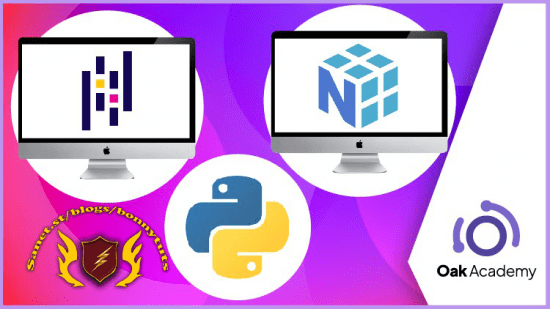
Published 10/2022
MP4 | Video: h264, 1280×720 | Audio: AAC, 44.1 KHz, 2 Ch
Genre: eLearning | Language: English | Duration: 87 lectures (10h 56m) | Size: 2.8 GB
NumPy & Python Pandas for Python Data Analysis, Data Science, Machine Learning, Deep Learning using Python from scratch
What you’ll learn
Pandas is an open source Python package that is most widely used for data science/data analysis and machine learning tasks.
Pandas is mainly used for data analysis and associated manipulation of tabular data in DataFrames.
Pandas is a fast, powerful, flexible and easy to use open source data analysis and manipulation tool, built on top of the Python programming language.
Pandas Pyhon aims to be the fundamental high-level building block for doing practical, real world data analysis in Python
Numpy is a library for the Python programming language, adding support for large, multi-dimensional arrays and matrices.
NumPy aims to provide an array object that is up to 50x faster than traditional Python lists.
NumPy brings the computational power of languages like C and Fortran to Python.
Installing Anaconda Distribution for Windows
Installing Anaconda Distribution for MacOs
Installing Anaconda Distribution for Linux
Introduction to NumPy Library
The Power of NumPy
Creating NumPy Array with The Array() Function
Creating NumPy Array with Zeros() Function
Creating NumPy Array with Ones() Function
Creating NumPy Array with Full() Function
Creating NumPy Array with Arange() Function
Creating NumPy Array with Eye() Function
Creating NumPy Array with Linspace() Function
Creating NumPy Array with Random() Function
Properties of NumPy Array
Reshaping a NumPy Array: Reshape() Function
Identifying the Largest Element of a Numpy Array: Max(), Argmax() Functions
Detecting Least Element of Numpy Array: Min(), Argmin() Functions
Concatenating Numpy Arrays: Concatenate() Function
Splitting One-Dimensional Numpy Arrays: The Split() Function
Splitting Two-Dimensional Numpy Arrays: Split(), Vsplit, Hsplit() Function
Sorting Numpy Arrays: Sort() Function
Indexing Numpy Arrays
Slicing One-Dimensional Numpy Arrays
Slicing Two-Dimensional Numpy Arrays
Assigning Value to One-Dimensional Arrays
Assigning Value to Two-Dimensional Array
Fancy Indexing of One-Dimensional Arrrays
Fancy Indexing of Two-Dimensional Arrrays
Combining Fancy Index with Normal Indexing
Combining Fancy Index with Normal Slicing
Fancy Indexing of One-Dimensional Arrrays
Fancy Indexing of Two-Dimensional Arrrays
Combining Fancy Index with Normal Indexing
Combining Fancy Index with Normal Slicing
Introduction to Pandas Library
Creating a Pandas Series with a List
Creating a Pandas Series with a Dictionary
Creating Pandas Series with NumPy Array
Object Types in Series
Examining the Primary Features of the Pandas Series
Most Applied Methods on Pandas Series
Indexing and Slicing Pandas Series
Creating Pandas DataFrame with List
Creating Pandas DataFrame with NumPy Array
Creating Pandas DataFrame with Dictionary
Examining the Properties of Pandas DataFrames
Element Selection Operations in Pandas DataFrames
Top Level Element Selection in Pandas DataFrames: Structure of loc and iloc
Element Selection with Conditional Operations in Pandas Data Frames
Adding Columns to Pandas Data Frames
Removing Rows and Columns from Pandas Data frames
Null Values in Pandas Dataframes
Dropping Null Values: Dropna() Function
Filling Null Values: Fillna() Function
Setting Index in Pandas DataFrames
Multi-Index and Index Hierarchy in Pandas DataFrames
Element Selection in Multi-Indexed DataFrames
Selecting Elements Using the xs() Function in Multi-Indexed DataFrames
Concatenating Pandas Dataframes: Concat Function
Merge Pandas Dataframes: Merge() Function
Joining Pandas Dataframes: Join() Function
Loading a Dataset from the Seaborn Library
Aggregation Functions in Pandas DataFrames
Coordinated Use of Grouping and Aggregation Functions in Pandas Dataframes
Advanced Aggregation Functions: Aggregate() Function
Advanced Aggregation Functions: Filter() Function
Advanced Aggregation Functions: Transform() Function
Advanced Aggregation Functions: Apply() Function
Pivot Tables in Pandas Library
Data Entry with Csv and Txt Files
Data Entry with Excel Files
Outputting as an CSV Extension
Outputting as an Excel File
Basic Knowledge of Python Programming Language
Basic Knowledge of Numpy Library
Basic Knowledge of Mathematics
Watch the course videos completely and in order.
Internet Connection
Any device where you can watch the lesson, such as a mobile phone, computer or tablet.
Determination and patience for learning Pandas Python Programming Language Library.
Password/解压密码www.tbtos.com
https://rg.to/file/d74dac8e9c9c30d93a196053c58a748e/Pandas_&_NumPy_Python_Programming_Language_Libraries_A-Z?.part1.rar.html
https://rg.to/file/b351bfac1de93d0dabfcabb08685304e/Pandas_&_NumPy_Python_Programming_Language_Libraries_A-Z?.part2.rar.html
https://rg.to/file/257fe78355fbeb917346615a177711f2/Pandas_&_NumPy_Python_Programming_Language_Libraries_A-Z?.part3.rar.html
https://rg.to/file/fdcb122863d351e63b9080657fdda3cb/Pandas_&_NumPy_Python_Programming_Language_Libraries_A-Z?.part4.rar.html
转载请注明:0daytown » Pandas & NumPy Python Programming Language Libraries A-Z™